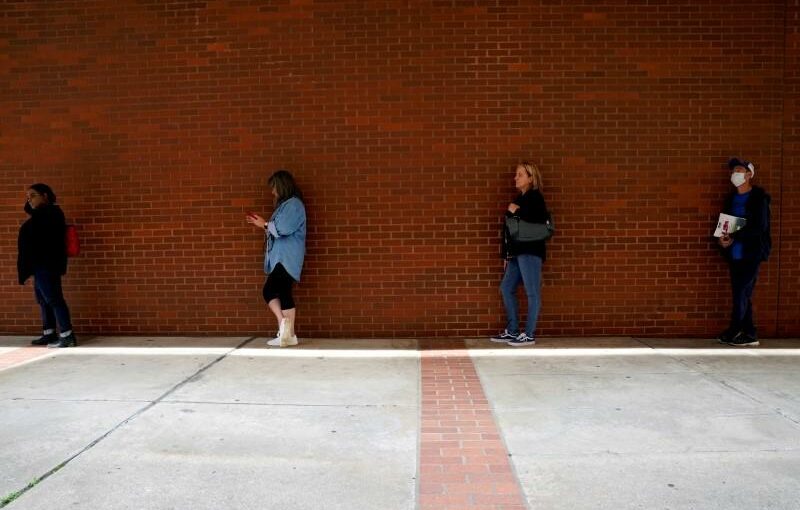WASHINGTON (Reuters) – The number of Americans filing new claims for unemployment benefits increased last week for the first time in 1-1/2 months, but layoffs are easing amid a reopening economy and a shortage of people willing to work.
While other data on Thursday showed factory activity in the mid-Atlantic region continuing to grow at a steady pace in June, a measure of future production surged to its highest level in nearly 30 years. Factories in the region that covers eastern Pennsylvania, southern New Jersey and Delaware also reported stepping up hiring, which bodes well for job growth this month.
The scarcity of labor is a hurdle to faster employment growth. The Federal Reserve on Wednesday held its benchmark short-term interest rate near zero and said it would continue to inject money into the economy through monthly bond purchases. The U.S. central bank brought forward its projections for the first post-pandemic interest rate hikes into 2023 from 2024.
“We continue to see labor market progress, but as has been the case through the pandemic, the situation remains fluid,” said AnnElizabeth Konkel, an economist at Indeed Hiring Lab. “We are in a wildly different place than we were in June 2020, but we have not crossed the finish line just yet.”
Initial claims for state unemployment benefits rose 37,000 to a seasonally adjusted 412,000 for the week ended June 12, the Labor Department said. That was the first increase since late April. Economists polled by Reuters had forecast 359,000 applications for the latest week.
The increase in claims was led by California, Kentucky and Pennsylvania. The four-week moving average of claims, considered a better measure of labor market trends as it irons out week-to-week volatility, fell 8,000 to 395,000.
The economy, ironically, is facing a labor crunch despite employment remaining 7.6 million jobs below its peak in February 2020. A shortage of childcare facilities is keeping some parents, mostly women, at home.
Generous government-funded unemployment benefits, including a $300 weekly check, have also been blamed, as well as a reluctance by some to return to work out of fear of contracting COVID-19 even though vaccines are widely accessible.
Pandemic-related retirements and transitions into new careers are also factors.
Fed Chair Jerome Powell told reporters on Wednesday he was “confident that we are on a path to a very strong labor market, a labor market that shows low unemployment, high participation, rising wages for people across the spectrum.”
The White House also struck an optimistic note on the labor market, with senior economic adviser Jared Bernstein saying: “I saw a labor market that continues to improve, continues to grow as shots in arms and checks in pockets have helped pull this recovery forward.”
Iowa, Mississippi and Missouri terminated all federal government-funded emergency benefits last Saturday, while Alaska ended only the $300 supplement. Twenty-one other states also led by Republican governors, including Texas and Florida, will end these benefits for residents between June 19 and July 10.
Louisiana is ending the weekly supplementary check on July 31, the only state with a Democratic governor to terminate the federal benefits. For the rest of the country, they will lapse on Sept. 6.
Iowa reported an increase in claims for the regular state unemployment insurance program last week, while Alaska Mississippi and Missouri saw declines. Only Alaska reported a decrease in claims for the government-funded Pandemic Unemployment Assistance.
Economists are watching the 26 states to see if their actions will boost employment or labor force participation over the summer, which could offer clues on labor market trends for the rest of the year when all government aid lapses.
There are a record 9.3 million job openings, while 9.3 million people are officially unemployed.
“We also could see added noise in the claims report if people end up trying to shuffle between programs or redetermine eligibility,” said Daniel Silver, an economist at JPMorgan in New York.
Stocks on Wall Street were mixed while the dollar rose against a basket of currencies. Longer-dated U.S. Treasury prices were trading higher.
STRONG FACTORY HIRING
In a separate report on Thursday, the Philadelphia Fed said its business conditions index dipped to a reading of 30.7 this month from 31.5 in May. But its measure of activity over the next six months surged to 69.2, the highest level since 1991, from 52.7 last month.
The survey’s gauge of factory employment in the mid-Atlantic region surged to 30.7 from a reading of 19.3 May. Factories also anticipated hiring more workers over the next six months, which offers further support to the labor market. Many, however, reported that labor shortages and supply chain bottlenecks were constraining their ability to fully use their resources.
Though layoffs are easing, initial claims remain well above the 200,000-250,000 range that is viewed as consistent with healthy labor market conditions. Claims have, however, dropped from a record 6.149 million in early April 2020.
Last week’s claims data included the period during which the government surveyed business establishments for the nonfarm payrolls component of June’s employment report. The economy created 559,000 jobs in May after adding 278,000 in April.
To get a better picture of how hiring fared in June, economists will await data next week on the number of people continuing to receive benefits after an initial week of aid.
The so-called continuing claims, which are reported with a one-week lag, edged up 1,000 to 3.518 million in the week ended June 5. There were 14.8 million people collecting unemployment checks under all programs at the end of May.
Source: Read Full Article
